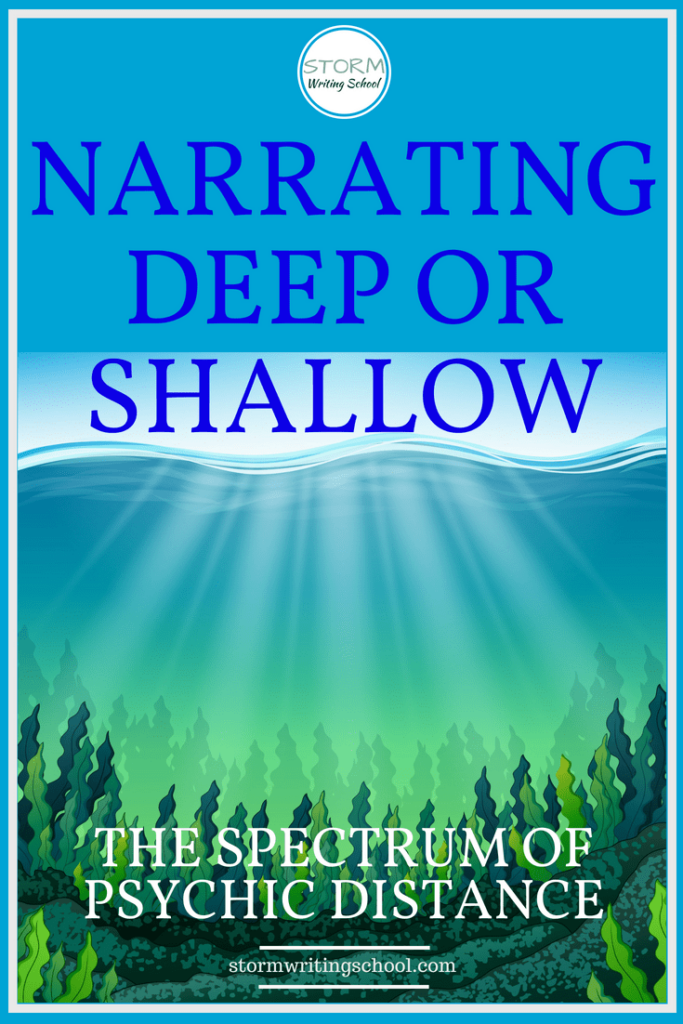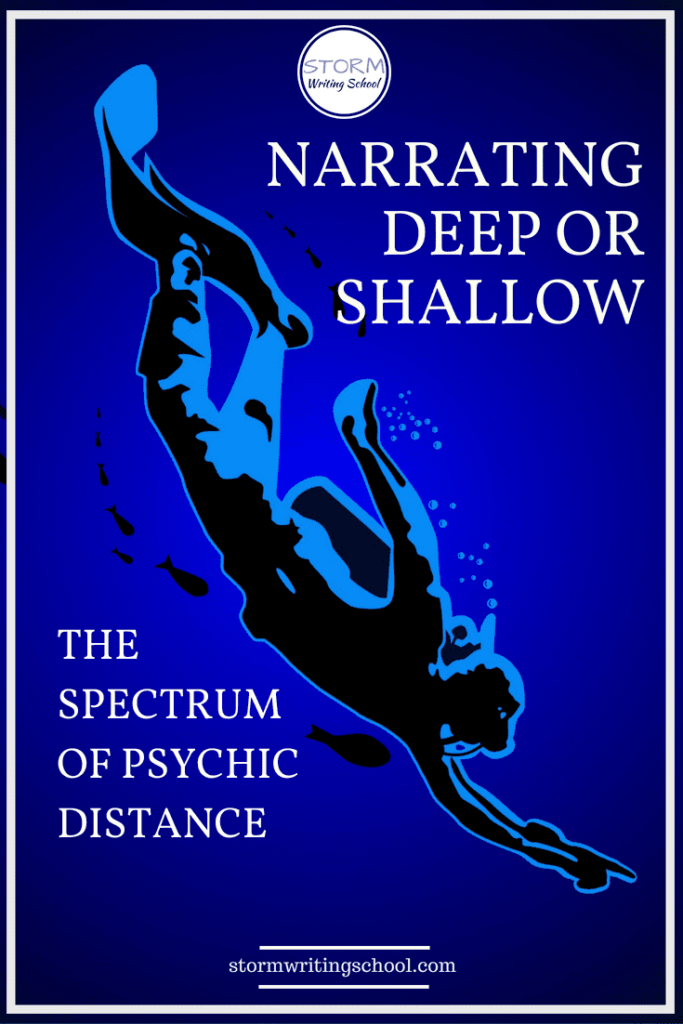An expert writer of stories needs to have some mastery of psychic distance—the distance the narrator stands from a character’s emotions, thoughts, and perceptions. No matter what viewpoint or person or verb tense you’re using for your story, your narration will sometimes go very close to character perception and sometimes stay quite distant.
Story is driven in large part by character reactions to events. And at the root of those reactions are feelings and thoughts. Not all of those feelings or thoughts need to be stated outright. But stories are usually richer when readers can make some guesses about what internal processes lead characters to behave as they’re behaving. Thus, allowing the reader to get a sense of characters’ interiority is absolutely essential.
So, here, I offer a spectrum of options available to your narrator.

I want to try to make this stuff as clear as possible, but narration is inherently a bit esoteric. You kind of have to embrace some level of writing geekery to comprehend it. And to really wrap your head around close narration, you first have to wrap your head around the concept that the narrator and the perspective character are not the same.
Narrator vs. Character
That’s right: the narrator of the story is always different from the character. Even if the narrator and the character are the same person.
If I tell a story about how my siblings and I used to catch toads and then have toad races in our front yard, even though I, the narrator, used to be the person who caught toads with his siblings and raced them in the front yard, I’m not the character in the story, who is ignorant about what would happen one particular afternoon when a hawk flew down and landed right next to us and our four toads.
And what would that hawk do? I’ll come back to that later.
For now, you just need to be clear on this fact: the character is living the events of the story; the narrator is telling the events of the story.
The Spectrum
The narrator can vary the extent to which they are inside the head of a character. I’m not talking about number of characters here; that’s a different discussion, which involves terms like limited, omniscient, head-hopping, and multiple perspective.
I’m talking about the “psychic distance” between the narrator and a character.
When it’s at it furthest, the narrator shows us no more than what we could see were we witnessing the character in real life. We’re solidly outside of the character’s mental processes.
But when we’re closest, the line between narrator and character gets fuzzy.
Here’s the spectrum:
Farthest (Outside)
We can still get a sense of what a character is thinking or feeling, even if we’re outside of the character entirely. In Cate Kennedy’s short story “Flexion,” Frank’s wife (unnamed) takes care of Frank after he ends up wheelchair-bound as a result of a tractor accident. We don’t ever get access to Frank’s thoughts or feelings (the wife is the viewpoint character), but we can intuit them from his behavior:
“I’m not going to be a burden on anyone, is that clear?” he mutters to her when the physios finally leave them alone for the afternoon. And knocks her hand away, as she goes to wipe some gravy off his chin.
We know that Frank is angry and humiliated and probably also mourning for his lost capability. It comes through in his dialogue and actions.
It’s to the benefit of every writer to practice this kind of conveyance of internal processes. If you don’t use it with your perspective or viewpoint characters, you’ll use it with others.
Far (Impression)
Sometimes, though, you may want to guide the reader a bit more. You can stay outside of the character but have the narrator sneak in an impression of the mood or thoughts of that character.
Here’s Charles Dickens in Our Mutual Friend:
She watched his face as earnestly as he watched the river. But, in the intensity of her look there was a touch of dread or horror.
That’s all on the outside, all something an external observer could witness, and yet, the Dickens narrator does sneak in some subjective impressions, telling us her watching was earnest and that her look was intense and contained a touch of dread or horror.
We’re a stone skipping over the water here, so to speak, getting very shallow glimpses into Lizzie’s interiority. (We could say that the “outside” distance is more like a bird flying over the surface of the water but never plunging into it.)
Again, this kind of conveyance of internal processes might be something you apply to characters other than your POV character, if not to the main characters of your story. So it’s worth toying around with. Finessed phrasing like “as though” and “seemed” can help you stay outside of the character while also allowing some labeling of the interiority.
Closer (Reported)
Our next level of depth would dip right into the water and tell us the thoughts of the character. Take this excerpt from Helene Weckler’s The Golem and the Jinni:
He left the dinner and walked back toward his tenement room. It was a bracing, frost-bitten night; the air knifed at his lungs. Perhaps, he thought, he would have a glass of araq— just one this time— and retire early. Then he saw that the lamp was still burning in the shop.
The first thing worth mentioning is how the verb “saw” differs from “watched” in the Dickens excerpt. A bystander can observe someone watching; watching is a physical act, as is staring and looking. But seeing is perceptual. So that verb marks a closer narrative distance to the character. We now know we’re dealing with a viewpoint character.
And then we also see his thoughts, spelled out clearly with the thought tag: “he thought.” Any instance of a narrator saying a character thought, realized, wondered, imagined, remembered, etc.—all of which are mental action verbs—will indicate that the narrator is reporting the internal workings of the character. Obviously.
This is like, I don’t know, a duck or a loon, half-in, half-out of the water. To say, “he thought” is still somewhat distancing. It still situates us outside of the character, but calls to us from the water to tell us whether it’s warm in there.
But we can go deeper still.
Closest (Immersion)
In the following excerpt, from Jess Walter’s “Anything Helps,” you can see how the character’s thoughts seep into the narration itself just a couple times. Here, he describes an addict who takes to panhandling at an intersection after a long hiatus from doing so:
Bit walks on, west toward his other spot. There are a few others out, stupid crankers—faces stupid, signs stupid: some forty-year-old baker with VIETNAM VET, too dumb to know he wasn’t born yet, and a coke ghost with tiny writing—Can You Help me feed My Children please. They’re at stupid intersections, too, with synced lights so the cars never stop.
See how that word “stupid” colors the narration? That’s not the narrator’s description of the people and intersections; it’s Bit’s assessment. The character’s language seeps into the narration.
Few authors immerse their narrators as fully into character as George Saunders. The story “Escape from Spiderhead” might offer the clearest demonstration of this ability. The protagonist, Jeff, takes part in futuristic clinical trials which test drugs that control emotions and feelings. At the story’s outset, Jeff is given a drug called Verbaluce, the effects of which build over the course of this paragraph in which Jeff is describing a beautiful garden:
He added some Verbaluce™ to the drip, and soon I was feeling the same things but saying them better. The garden still looked nice. It was like the bushes were so tight-seeming and the sun made everything stand out? It was like any moment you expected some Victorians to wander in with their cups of tea. It was as if the garden had become a sort of embodiment of the domestic dreams forever intrinsic to human consciousness. It was as if I could suddenly discern, in this contemporary vignette, the ancient corollary through which Plato and some of his contemporaries might have strolled; to wit, I was sensing the eternal in the ephemeral.
The Levels
So there’s your spectrum for narrating character interiority.
- Fully external: just an outside view.
- Subjective external: an outside view with stated impressions of interiority.
- Reported interiority: stating internal thoughts or emotions (mostly with mental action verbs).
- Immersion: the narration takes on the language of a character.
And a quick sentence for each level:
- Jane’s eyebrows shot up as the toddler began thrusting his hips.
- The toddler broke into a suggestive dance. Jane’s eyebrows lifted in what appeared to be amusement.
- The toddler broke into a suggestive dance. Jane wondered where he’d learned such moves.
- Jane watched the toddler thrust his hips, and, then, oh God, was he twerking? This had to stop.*
*Based on a true story. In which I was “Jane.”
A Word on “Deep POV”
Now, if you’ve poked around online in search of POV information, you’ve likely come across some articles describing “deep POV.” Deep POV is that fourth level I describe above, the immersion. And it’s nothing new, by the way. It’s sometimes called free indirect style; I prefer “close narration” myself.
There’s definitely a trend toward close narration in stories published these days—a trend not likely to change soon. As James Wood says, “As soon as someone tells a story about a character, narrative seems to want to merge with that character, to take on his or her way of thinking or speaking.”
So I do think it’s worth mastering close narration (deep POV). In fact, the third level above (reported interiority) can often come across as telling, whereas close narration almost always feels like showing.
There are some pretty good tips out there regarding the execution of “deep POV.” If you’re finding difficulties with deep POV, let me know in the comments or via email, and maybe I’ll put together a little tutorial.
But that’s a topic for a different day. Here, I just wanted to clarify the various levels of psychic distance.
As for the hawk who landed beside the toads: it hopped over to my toad, grabbed it, and flew with it to the neighbor’s roof. It was traumatic. I don’t want to talk about it.
Practice
1) Psychic distance safari: pick up a favorite book and examine a passage of it for each level listed above. There’s a slim change you’ll have picked up a book which has no close narration, in which case you’ll definitely find the other three. And finding impressions of interiority might take some searching of more than one passage. But you should be able to easily find three levels within any given passage.
2) Writing exercise: Try what I did above with my sentence about Jane and the dancing toddler. Recast the same sentence in four ways.
3) Apply to scenes: Now look back through a scene you’ve written and rewrite at least a couple of pages of it in two ways. For one rewrite, try to stay completely outside. Only use the far distances (outside and impression). For the other rewrite, try to stay completely inside. Only use the close distances (reported and immersion).
The above are exercises, but they have some wonderful payoff. You can really only learn about the nuances of POV by experimenting with different narrations.
Below are a few extras for those who may want to learn even more about going close with pyschic distance.
For the Nerds
Find this stuff interesting? Want to learn a little more about close narration, aka deep POV, aka “free indirect style”? Jane Austen can help. Click to reveal more:
[showhide type=”pressrelease” more_text=”Show” less_text=”Hide” hidden=”yes”]
In his book The Dual Voice: Free Indirect Speech and Its Functioning in the 19th Century European Novel, Roy Pascal explains free indirect style and points to Jane Austen as one of the novelists most responsible for its rise.
First of all, here’s Pascal’s examples of direct speech, indirect speech, and free indirect style. (The label “free indirect style” is not all that intuitive; it’s “freed” of “its authorial flagging,” James Wood explains.)
- Direct speech: He stopped and said to himself, “Is that the car I saw here yesterday?”
- Indirect speech: He stopped and asked himself if that was the car he had seen there the day before.
- Free indirect style: He stopped. Was that the car he had seen here yesterday?
I’ve combed through Pride and Prejudice to find an illuminating example for you.
The context: in the aftermath of Lydia eloping with Wickham, Mr. and Mrs. Bennet argue about whether Lydia should be given money. Pride and Prejudice has an omnscient narrator who, here, moves toward Mrs. Bennet’s thoughts. And I’m just underlining the evidence that it’s Mrs. Bennet’s perspective we’re getting here, not the free indirect style. See if you can spot free indirect yourself:
Mrs. Bennet found, with amazement and horror, that her husband would not advance a guinea to buy clothes for his daughter. He protested that she should receive from him no mark of affection whatever on the occasion. Mrs. Bennet could hardly comprehend it. That his anger could be carried to such a point of inconceivable resentment as to refuse his daughter a privilege without which her marriage would scarcely seem valid, exceeded all she could believe possible.
Now, again, those underlined bits are not free indirect speech. They’re merely the indicators of whose head we’re currently in. We see the free indirect style most clearly in the noun clause, “That his anger could be carried to such a point of inconceivable resentment as to refuse his daughter a privilege without which her marriage would scarcely seem valid.”
The first tip-off is the word “inconceivable.” See how that’s a word the character, not the narrator, would use to judge these circumstances? And then “a privilege without which her marriage would scarcely seem valid” is definitely Mrs. Bennet’s phrasing/assessment, not the narrator’s.
Check out Austen’s work via the Gutenberg Project. Her novels are available for free. Peruse for other instances of close narration or free indirect style.
[/showhide]
First-Person Narration
And if you’re dealing with a first-person narrator, click below to see a little more about how close narration works with first person.
[showhide type=”pressrelease2″ more_text=”Show” less_text=”Hide” hidden=”yes”]
First-person, present-tense narration is probably the POV trying hardest to make you forget the distinction between narrator and character, but there is one.
Below is a passage from Tomi Adeyemi’s Children of Blood and Bone. In fact, this is the beginning of the book. All we know is that the chapter has the heading “Zélie,” which is the name of the perspective character here:
Pick me.
It’s all I can do not to scream. I dig my nails into the marula oak of my staff and squeeze to keep from fidgeting. Beads of sweat drip down my back, but I can’t tell if it’s from the morning heat or from my heart slamming against my chest. Moon after moon I’ve been passed over.
Today can’t be the same.
Go ahead and skip the “Pick me,” which is clearly the character. We want to look for the subtler instances of close narration. And here’s a tip. Recast the passage in past tense to make it clearer to identify.
“It’s all I can do not to scream” becomes “It was all I could do not to scream.” That’s reported interiority. As is “But I couldn’t tell if it was from the morning heat or from my heart slamming against my chest.”
It’s the “Today can’t be the same” (“Today couldn’t be the same”) that is close narration. See how there’s no reporting about the mental processes of the character? “All I can do not” and “I can’t tell” are your giveaways that those sentences are reported interiority. But “Today can’t be the same” immerses us directly into the character’s head.
[/showhide]
Read More
I’ve talked about psychic distance before. Check out these other articles:
- Formatting Character Thoughts explains why mastery of close narration means you can pretty much forego using italics.
- Author, Narrator, Character explains the distinction between those three entities.
- Juggle External Action and Interiority discusses some tricks for narrating interiority.









7 Responses
This is so helpful! I’ve heard of physic distance before. I actually tend toward first person, which uses close immersion most. But I just intuitively realized that keeping in one head meant I had to use the other perspectives for other characters, from the MC’s POV. “He seemed” or “I assumed he felt” such-and-such. It’s so helpful to have it all laid out, and this is the easiest to understand I’ve seen so far! Thanks!
I also have to mention that I’m a huge Jane Austen junkie and love her style of third-person, shifting back and forth through those different perspectives. I will pay more attention to specific words and verb tenses as I’m currently reading through her entire works yet again. 😉
Thanks, Lila! I’m so glad to hear this was helpful and easy to understand. And let me know if you come upon new insights in looking back through Austen.
As an analogy, this made me think of classical acting vs. method acting.